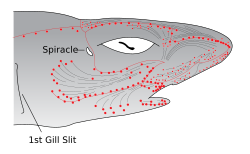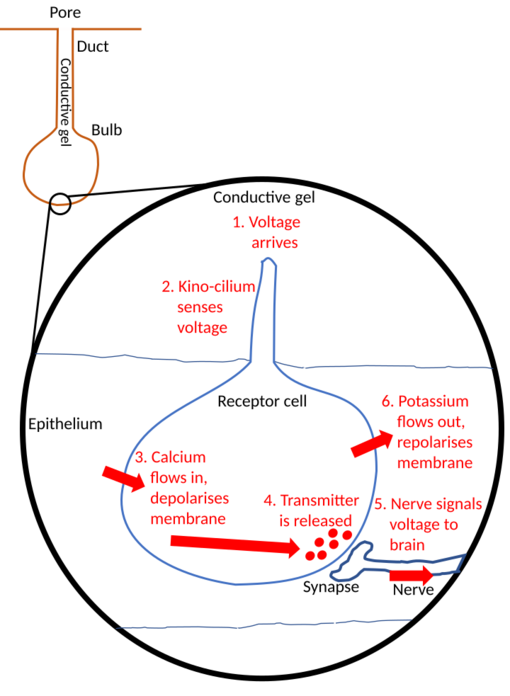Ampullae of Lorenzini facts for kids
Ampullae of Lorenzini (say: am-POO-lay of loh-ren-ZEE-nee) are special sense organs that can detect electric fields. Think of them as a natural "electric detector" for certain fish! They are tiny pores in the skin, filled with a jelly-like substance. These pores are connected to sensory bulbs inside the fish.
You can find these amazing organs in cartilaginous fish like sharks, rays, and chimaeras. Some bony fishes also have them, such as reedfish, sturgeon, and lungfish. These organs are very old in terms of evolution. Most bony fish and land animals have lost them over time.
Contents
How We Found Them
A scientist named Marcello Malpighi first described these organs. Later, in 1679, an Italian doctor named Stefano Lorenzini gave a more detailed description. However, for a long time, no one knew what they were for!
In the 20th century, scientists did experiments. They thought the ampullae might sense temperature, pressure, or even saltiness. But in 1960, a big discovery was made: these organs are special receptors for sensing electric fields! It was a huge step in understanding how these fish interact with their world.
How They Developed
The Ampullae of Lorenzini are linked to the lateral line organs. Lateral line organs help fish sense movement and vibrations in the water. Over time, the ampullae evolved from these older sensory organs.
Having these electric-sensing organs is an ancient trait in vertebrates (animals with backbones). This means that the very first vertebrates likely had them. Today, you can find Ampullae of Lorenzini in:
- Cartilaginous fish (sharks, rays, chimaeras)
- Lungfishes
- Bichirs
- Coelacanths
- Sturgeons
- Paddlefishes
- Some aquatic salamanders and caecilians
Most bony fish and land animals lost these organs as they evolved.
| Vertebrates |
|
|||||||||||||||||||||||||||||||||||||||||||||||||||||||||
What They Look Like
Each ampulla is made of a group of sensory cells. These cells have many nerve fibers. They are located in a sensory bulb, which is covered by a strong collagen layer. A jelly-filled canal leads from this bulb to a tiny pore on the skin's surface.
The jelly inside the canal is special. It's made of a substance called glycoprotein. This jelly has similar electrical properties to seawater.
These pores are usually found in groups around the snout and mouth of sharks and rays. Their size often matches the animal's body size. However, the number of ampullae stays about the same. Some canals open to the outside, while others don't. The ones that don't open might help with touch, preventing dirt from getting in.
-
Pores of ampullae of Lorenzini on the snout of a tiger shark.
-
The electroreceptive ampullae of Lorenzini (red dots) developed from the lateral line organs (gray lines) of early vertebrates.
Sensing Electricity
The ampullae detect electric fields in the water. They sense the difference in electrical voltage between the pore on the skin and the base of the sensory cells.
If the pore has a positive electrical charge, the nerve activity from the cells slows down. If it has a negative charge, the nerve activity speeds up. This change in nerve signals tells the fish's brain about the electric field.
Sharks are incredibly good at sensing electric fields. They can detect very tiny electric signals, even as small as 5 nanovolts per centimeter. This is much more sensitive than any other animal!
All animals, including prey fish, create small electric fields when their muscles move. Electroreceptive fish can pick up these weak signals. This helps them find hidden prey, even if they can't see or smell them.
For example, the sawfish has more ampullary pores than any other cartilaginous fish. This makes it a specialist in sensing electricity. Sawfish have these pores all over their head, snout, and body.
Sensing Magnets
The Ampullae of Lorenzini also help fish sense Earth's magnetic field. This is called magnetoreception. Since magnetic and electric fields are related, these organs can pick up magnetic information.
A study in 2004 showed this. Sharks were placed in a tank with a magnetic field that could be turned on or off. When the magnetic field was on, food was given at a certain spot. The sharks learned to go to that spot when the field was on, even without food. This showed they could detect the magnetic field.
This ability helps sharks and rays find their way during long migrations. The Earth's magnetic field changes slightly across the globe. This gives these animals a natural "GPS system." They use the strength and direction of the magnetic field to know where they are.
This built-in GPS is super important for sharks. It helps them travel long distances and return to their "home" areas. By migrating, sharks help move nutrients around different ocean ecosystems. Without their magnetic sense, they might get lost, which could upset the balance of the food web.
Sensing Temperature
For a while, scientists thought the jelly inside the ampullae might also sense temperature changes. They thought it could turn temperature differences into electrical signals. This would allow fish to detect tiny changes in water temperature.
A study in 2007 seemed to disagree with this idea. However, the question remained open. In 2023, new predictions suggested that sharks' ampullae might indeed be able to detect a temperature difference as small as 0.001 Kelvin (one-thousandth of a degree!). This is a very tiny difference!
See Also
- Knollenorgan – another type of electroreceptor found in some fish, but not related to the ampullae of Lorenzini.





